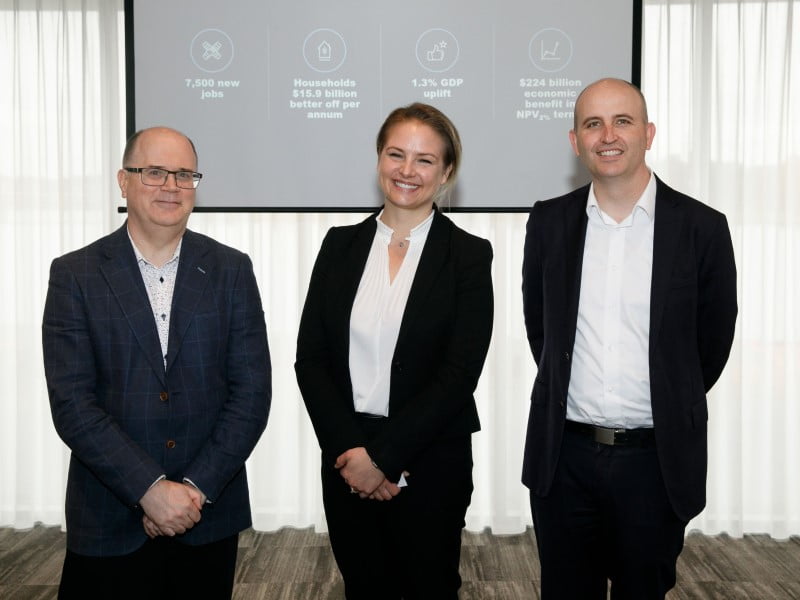Despite the potential to expand the Australian economy by at least more than $252 billion over the next decade, uptake of software-as-a-service has still not been widespread, according to a new TechnologyOne report.
Shifting away from legacy on-premise systems could add an additional 1.3 per cent to Australia’s GDP or almost the equivalent of opening another North West Shelf, according to a report commissioned by TechnologyOne.
The modelling in the report also predicts it could make households at least $15.9 billion better off per annum.
Co-authors Melanie Kelly, Director at Insight Economics, and Dr Joseph Sweeney, Advisor at Intelligent Business Research Services, presented their findings to guests at InnovationAus.com’s The Pause Breakfast event on Wednesday. Also in attendance was Committee for Economic Development of Australia chief economist Jarrod Ball, who served as moderator.

The economic gains from moving to software-as-a-service (SaaS) come from improving the productivity of work already carried out and not from cutting costs, according to Dr Sweeney. Both Ms Kelly and Dr Sweeney also emphasised that the findings in this report were comparatively conservative.
“One of the big challenges that we have in Australia, more so than any other market I’ve seen, is that we don’t measure the results of our investments in a granular enough manner,” Dr Sweeney said.
“In this report, we only probably counted about 10 per cent of the actual benefits or the productivity savings because most people don’t even measure them or know that they’re there, which is crazy because all these tools that we’re deploying can do that for us automatically.”
“Even with this conservative approach, the report shows that the opportunity costs of legacy and inefficient ICT solutions and work processes are hugely significant. For example, if we look just at say the federal and state government savings…that amounted to roughly $62 billion in benefits to be realized over the next 10 years,” Ms Kelly added.
Dr Sweeney also said there was a need for management to change the way they think about productivity dividends. This would entail accounting for potential efficiency gains through SaaS transformation so that IT departments are given a sufficiently large budget to purchase it.
Ms Kelly also said that businesses need to also consider the wider business benefits and consumer impacts rather than focusing to narrowly on ICT costs.
“Your business case needs to step back and widen the lens and think about those broader effects and I think this [model] provides a really good framework for stepping through and thinking about those broader effects across the business,” Ms Kelly said.
She also highlighted the fallacy that cloud services were less secure than on-premise legacy systems, particularly for governments.
“Historically there has been that concern that maybe [SaaS] is less safe, you know, maybe it’s less safe, but actually, in an on-premises system the costs of trying to achieve an equivalent level of security almost incalculable. The scale and sophistication that you get through some of these advanced offerings has become a new driver that definitely has come up in conversations around [SaaS] thinking,” Ms Kelly said.
Mr Ball said that the report clearly outlined the benefits of businesses migrating to SaaS, but noted three factors that have resulted in technology being left out of policymakers’ conversations on microeconomic reform.
“I think there’s been a level of complacency. Which has been borne out of continuing growth in such a long consistent period of economic growth, and even coming out of COVID. That experience has been much better than economists, like myself, feared it would be,” Mr Ball said.
“But we are now coming into a much more constrained and difficult economic environment, in terms of inflation and an ageing population. These economic issues are now front and centre, which I think will drive a much stronger focus on whether policymakers talk about productivity or not.
“The other thing is that we haven’t had a level of policy consistency in terms of innovation and industry policy, in terms of certainty and being able to think about investment decisions that you make. We have had a lot of different programs, a lot of chopping and changing.
“When I look at other jurisdictions who are doing this well. There’s a lot of consistency. There’s a lot of central coordination in terms of the agencies that do it. There’s a lot of certainty and a lot of confidence that comes from that.
“The final area is really around communication and getting broader community support and awareness around the importance of technology. We have had some people who’ve had a go at this, but I think we’ve just got to keep trying. Certainly, I would say in the last 12 to 18 months, the presence of new organisations in this debate and making those points has really lifted the debate.”
Do you know more? Contact James Riley via Email.

